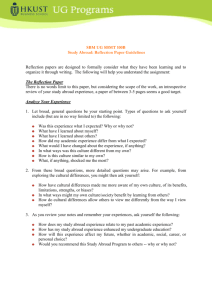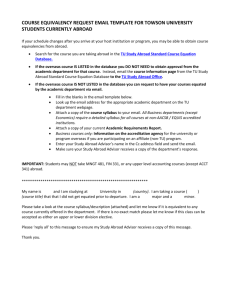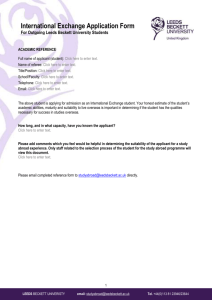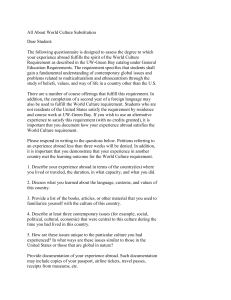Civilian Americans Overseas and Voter Turnout
advertisement
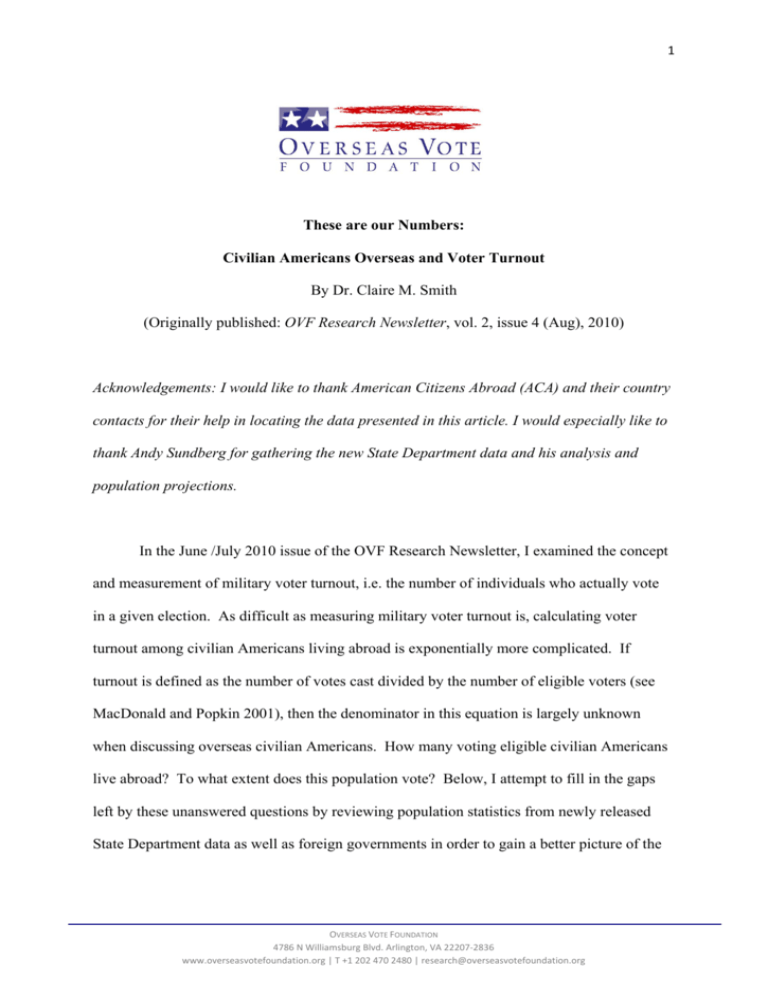
1 These are our Numbers: Civilian Americans Overseas and Voter Turnout By Dr. Claire M. Smith (Originally published: OVF Research Newsletter, vol. 2, issue 4 (Aug), 2010) Acknowledgements: I would like to thank American Citizens Abroad (ACA) and their country contacts for their help in locating the data presented in this article. I would especially like to thank Andy Sundberg for gathering the new State Department data and his analysis and population projections. In the June /July 2010 issue of the OVF Research Newsletter, I examined the concept and measurement of military voter turnout, i.e. the number of individuals who actually vote in a given election. As difficult as measuring military voter turnout is, calculating voter turnout among civilian Americans living abroad is exponentially more complicated. If turnout is defined as the number of votes cast divided by the number of eligible voters (see MacDonald and Popkin 2001), then the denominator in this equation is largely unknown when discussing overseas civilian Americans. How many voting eligible civilian Americans live abroad? To what extent does this population vote? Below, I attempt to fill in the gaps left by these unanswered questions by reviewing population statistics from newly released State Department data as well as foreign governments in order to gain a better picture of the OVERSEAS VOTE FOUNDATION 4786 N Williamsburg Blvd. Arlington, VA 22207-2836 www.overseasvotefoundation.org | T +1 202 470 2480 | research@overseasvotefoundation.org 2 number of civilian Americans abroad. Second, I calculate national voter turnout rates using data from the U.S. Election Assistance Commission (EAC). U.S. Census Data As discussed in the premier issue of the OVF Research Newsletter, there are two primary sources for data on the number of civilian Americans living abroad (Smith 2009). The first is the U.S. Census Bureau. The 2000 Census included approximately 580,000 federal employees and dependents (226,363 military personnel, 30,576 civilian employees, and 319,428 dependents of military and civilian employees) in their 2000 apportionments (U.S. Census Bureau 2001). The Bureau documented how difficult it is to measure this population in its 2001 report: “The Census Bureau does not know the number of private Americans living abroad under the other categories. No accurate estimate exists of the total number of Americans living abroad or of the other components of this population.” Because of these difficulties, the Bureau will not include overseas Americans in the 2010 census. U.S. State Department Data The second source of data is the U.S. State Department. In July 1999, the Bureau of Consular Affairs estimated that 3,784,693 private American citizens lived overseas. Unfortunately for those who are interested in overseas voters, this figure has not been updated by the State Department since 1999, even though the general number of 5,256,600 was released in 2009. They have confirmed that there are more current estimates but, because of security concerns, it will not release them publicly. In 2010, the Bureau of Consular Affairs of the U.S. State Department released new data on the number of children born abroad as U.S. citizens during the ten year period of 2000 to 2009. 503,585 consular reports of birth abroad (CRBA) were made and passports issued as a result by U.S. embassies between 2000 and 2009, as seen in Table 1. On a regional basis, more U.S. citizen children were born in Europe than any other region and OVERSEAS VOTE FOUNDATION 4786 N Williamsburg Blvd. Arlington, VA 22207-2836 www.overseasvotefoundation.org | T +1 202 470 2480 | research@overseasvotefoundation.org 3 accounted for 40 percent of births in 2000. Europe’s importance appears to be decreasing and it represented less than 30 percent of total births by 2009. Eastern Asia and the Western Hemisphere had roughly the same number of births in 2009, about 24 percent. While South and Central Asia and Africa have shown the most rapid growth in percentage terms, in numbers of births per year they still account for only a tiny portion of the worldwide total. Table 1 Births of U.S. Citizen Children Abroad by Region Region 2000 2001 2002 2003 2004 2005 2006 2007 Number of Total Births by Region Each Year 17,346 17,592 18,323 19,280 19,076 17,684 2008 2009 2000-2009 18,144 18,131 2000-2009 181,210 Europe Eastern Asia and Pacific Western Hemisphere Near Eastern Asia Africa South and Central Asia Total 17,957 17,677 9,304 9,656 9,668 10,338 11,076 11,676 11,771 13,314 13,662 14,787 115,252 10,150 11,189 9,875 10,119 10,752 11,733 11,912 13,062 14,098 14,324 117,214 60,059 6,362 5,156 5,541 5,834 6,520 7,207 7,073 8,866 10,017 68,635 708 715 758 830 886 1,001 1,207 1,364 1,583 1,723 10,775 626 708 695 721 1,022 1,149 1,232 1,242 1,436 1,668 10,499 44,804 46,307 43,498 45,141 47,893 51,359 52,405 53,739 57,789 60,650 503,585 Europe Eastern Asia and Pacific Western Hemisphere Near Eastern Asia Africa South and Central Asia Total 40.08% 38.17% Percent of Total Births by Region Each Year 39.88% 38.97% 38.26% 37.54% 36.40% 32.91% 31.40% 29.89% 2000-2009 35.98% 20.77% 20.85% 22.23% 22.90% 23.13% 22.73% 22.46% 24.78% 23.64% 24.38% 22.89% 22.65% 24.16% 22.70% 22.42% 22.45% 22.85% 22.73% 24.31% 24.40% 23.62% 23.28% 13.52% 13.74% 11.85% 12.27% 12.18% 12.69% 13.75% 13.16% 15.34% 16.52% 13.63% 1.58% 1.54% 1.74% 1.84% 1.85% 1.95% 2.30% 2.54% 2.74% 2.84% 2.14% 1.40% 1.53% 1.60% 1.60% 2.13% 2.24% 2.35% 2.31% 2.48% 2.75% 2.08% 100% 100% 100% 100% 100% 100% 100% 100% 100% 100% 100% Source: State Department Number of Post Actual CRBA Passports Issued If we examine country results, Germany, Mexico, Japan and Great Britain account for more than a quarter of total births. Although births per year have declined in Germany over the past ten years, they have grown in Mexico, Japan, Great Britain, Canada, and the Philippines. OVERSEAS VOTE FOUNDATION 4786 N Williamsburg Blvd. Arlington, VA 22207-2836 www.overseasvotefoundation.org | T +1 202 470 2480 | research@overseasvotefoundation.org 4 Andy Sundberg of American Citizens Abroad (ACA) used this information to calculate the number of U.S. civilians abroad in 2009. When the number of children born abroad in 2009 (60,650) is adjusted using the U.S. national birth rate of 14 children per 1,000, he produces an estimate of 4.3 million. However, not all overseas families are composed of two U.S. citizen parents. A study conducted in 1980 by the State Department indicated that only about two out of three children born abroad had two US citizen parents. Assuming then that only 65 percent of the families into which a child was born abroad in 2009 had two US citizen parents, the gross estimated number of US citizens abroad, based on the number of births, would be too high and must be adjusted. Using this 65 percent estimate of two citizen parents and 35 percent of only one citizen parent, the overall number of parents who are US citizens based on births abroad falls to only 83 percent of the original population estimate. Sundberg argues that this implies that the actual number of U.S. citizens living abroad was only 3.6 million in 2009. Data from Foreign Governments There is another important data resource that has not been previously utilized and which can be used to create a more accurate estimate of civilian Americans abroad: population estimates produced by foreign governments. Just as the U.S. monitors the number of immigrants living within its borders, so do other governments. Foreign governments collect data in two ways. First, several countries, such as Germany, require residents to register in the town or city where they live. Because of this requirement we can be very certain about the numbers obtained. For example, in December 2007, the Central Register of Foreigners reported that 99,891 Americans were registered and lived in Germany (Federal Statistical Office of OVERSEAS VOTE FOUNDATION 4786 N Williamsburg Blvd. Arlington, VA 22207-2836 www.overseasvotefoundation.org | T +1 202 470 2480 | research@overseasvotefoundation.org 5 Germany 2007). This number does not include dual citizens or U.S. military personnel stationed in the country. Austria also has the same requirements. Second, many countries, such as Ireland, the United Kingdom and Canada, ask questions about foreign origin in their census. For example the United Kingdom produces a series of surveys in addition to its census. The Labour Force Survey (LFS) covers 120,000 respondents per quarter and the Annual Population Survey (APS) around 340,000 respondents. Because of its extra coverage the APS is the best guide for population data. Similar to U.S. population surveys, these studies draw a statistically valid sample and ask respondents their country of origin. From October 2008 to September 2009 the UK APS estimated 189,000 foreign born Americans living in the UK with a confidence level between 0 and 5 percent, indicating plus or minus 18,000 individuals. This estimate is considered precise. In cooperation with American Citizens Abroad (ACA), OVF attempted to collect information from different foreign governments. The methodology for selecting countries for the study was informal, and there were two criteria for inclusion. First, we considered the size of the country among current population estimates. According to State Department estimates, over half of the American abroad population lives within 20 countries. Furthermore, among OVF’s 2008 Post-Election Survey respondents (about 24,000 individuals) 61.1 percent of voters lived in just ten countries. The second criterion was availability of information. Unfortunately, several European countries (such as Spain and France) do not post this information on their websites and therefore could not be included in this study, whereas others with relatively small U.S. foreign populations (such as Austria) provide usable information. Additionally, not every country provides estimates for every year. OVERSEAS VOTE FOUNDATION 4786 N Williamsburg Blvd. Arlington, VA 22207-2836 www.overseasvotefoundation.org | T +1 202 470 2480 | research@overseasvotefoundation.org 6 Finally, there are several countries that do not report their immigrant groups by country, but rather by region. Therefore, all immigrants from North America (i.e. Canada and Mexico) are included in their count. Austria is among these countries. Surprisingly, many countries do not release detailed information about the number of immigrants within their borders. For example, documenting the number of Americans living in Israel can be difficult. During the 2008 presidential election both U.S. political parties widely used the number of 250,000 Americans living and studying in Israel. This estimate was based on the number of university students, estimated number of immigrants, and those returning to America. The 2009 Statistical Abstract of Israel, on the other hand, reports that 88,839 U.S. born individuals immigrated to Israel between 1952 and 2008. Mexico was also not included in this study, as we were unable to locate any information on their website. Previous research indicates that the number of U.S. Americans living in Mexico is around 1 million, with 600,000 of those living in Mexico City. In 2000, the US Embassy in Mexico City reported 124,082 individuals. Mexico is currently conducting its 2010 census. Results As seen in Table 2, our quick survey of these 10 countries accounts for almost one million civilian Americans living abroad. As mentioned above, this modest estimate only includes the countries with the largest American expat communities, and some those (such as Spain, France and Mexico) are missing. Based on State Department estimates and OVF Survey results, if the countries covered here represent 60 percent of the population abroad, then we can approximate about 3 million private citizens living abroad. It is important to note that these numbers are civilian Americans, primarily living overseas indefinitely. They tend not to include university students, dual citizens or military personnel. OVERSEAS VOTE FOUNDATION 4786 N Williamsburg Blvd. Arlington, VA 22207-2836 www.overseasvotefoundation.org | T +1 202 470 2480 | research@overseasvotefoundation.org 7 Table 2: Americans Abroad, Foreign Government Estimates 2009 Australia Austria Canada Germany Ireland Israel Japan Switzerland UK 2008 2007 8,755 8,422 8,043 98,352 100,002 99,891 250,000 17,757 184,000 16,669 188,000 2006 61,715 7,779 250,535 99,265 12,475 38,581 15,621 161,000 2005 2004 2003 2002 7,527 7,326 7,233 7,350 97,864 96,642 112,939 112,943 15,335 153,000 14,913 145,000 14,877 15,005 2001 2000 6,108 14,915 38,804 14,153 Total Ten Year Average: 10 year average 61,715 7,616 250,535 102,237 12,475 250,000 38,693 15,472 166,200 904,943 Sources: See works cited for detailed list of government agencies used. There are also several trends that can be observed in Table 1. First, the majority of civilian Americans living abroad live in Canada, the UK, Germany, Israel and Australia. Second, the number of Americans appears to be decreasing in Germany, but is relatively stable across time. The number of Americans in the UK and Switzerland appears to be increasing. This review has also uncovered some inconsistencies in the reported data. Although the State Department estimates more than 100,000 Americans live in Greece, the Greek Statistical Authority reports that only 1,769 Americans lived in the country in 2006. The European Commission gathers and stores data from all 27 European Union members in its Eurostat database. This database provides a nice compliment to the data collected from the countries directly. The statistics from Eurostat are able to fill-in some information. For example, although we could not locate any information via the Spanish websites, Eurostat reports that around 33,000 U.S. Americans live in Spain. As seen in Table 3, according the Eurostat, over 500,000 U.S. Americans lived in Europe between 2005 and 2009. OVERSEAS VOTE FOUNDATION 4786 N Williamsburg Blvd. Arlington, VA 22207-2836 www.overseasvotefoundation.org | T +1 202 470 2480 | research@overseasvotefoundation.org 8 Table 3: Population of U.S. Citizens in EU Countries, 2005 to 2009 Belgium Bulgaria Czech Republic Denmark Germany Estonia Ireland Greece Spain France Italy Cyprus Latvia Lithuania Luxembourg Hungary Malta Netherlands Austria Poland Portugal Romania Slovenia Slovakia Finland Sweden United Kingdom 2005 . . 2,668 9,008 96,642 . 18,100 . 31,633 48,174 14,155 . 789 1,475 . 1,699 . 22,635 7,964 . . 1,707 676 3,453 3,118 15,301 153,000 2006 . . 3,198 9,170 97,864 . 20,100 . 35,386 . 14,433 . 844 1,262 . 1,929 . 22,769 8,229 . . . 671 . 3,249 15,522 161,000 2007 . . 3,430 9,169 109,447 . 19,963 . 30,831 . 14,904 . 726 1,627 . 1,931 . 23,028 8,591 . 8,560 1,761 683 . 3,465 15,225 188,000 2008 14,603 166 2,488 10,074 110,368 . 20,833 . 33,067 . 15,036 . 694 1,741 . 2,343 155 23,256 9,060 . 8,733 2,066 652 . 3,659 15,309 184,000 2009 . 163 2,808 10,326 109,710 . 21,489 . 34,944 . 15,324 . 750 . . 2,380 . 23,986 9,416 14,011 2,484 2,545 668 . 3,761 15,901 . TOTAL: Average 14,603 165 2,918 9,549 104,806 . 20,097 . 33,172 48,174 14,770 . 761 1,526 . 2,056 155 23,135 8,652 14,011 6,592 2,020 670 3,453 3,450 15,452 171,500 501,688 Source: European Commission Eurostat Voting Statistics If there are between 4 and 3 million private U.S. civilians living abroad (the high and low estimates presented by Sundberg and foreign government data), how many of them voted? What was civilian voter turnout in 2008? The EAC provides statistics on military and civilian overseas voters for the 2008 election. As seen in Table 4, depending on how ballots are defined, between 500,000 and 375,000 ballots were transmitted to U.S. citizens living abroad. The reason for this uncertainty is the larger number of ballots listed as “other voter” and “not categorized.” 221,924 absentee ballots and 9,161 federal write-in absentee ballots (FWABs) were submitted for counting. OVERSEAS VOTE FOUNDATION 4786 N Williamsburg Blvd. Arlington, VA 22207-2836 www.overseasvotefoundation.org | T +1 202 470 2480 | research@overseasvotefoundation.org 9 Table 4: Overseas Civilian Voter Statistics, 2008 Ballots Transmitted All ballots minus military personnel 508,450 Ballots Submitted for Counting Absentee Ballots 221,924 Ballots Counted Absentee Ballots 179,866 Reported as “non-military / civilian” 374,955 FWABs 9,161 Other 42,323 Total 273,408 FWABs 7,609 Other 75,137 Total 262,612 Source: EAC 2008 UOCAVA Survey The ballot return rate is the number of ballots submitted for counting (not including FWABs) divided by the number of ballots transmitted. In 2008 the ballot return rate for nonmilitary civilian voters was 59.2 percent. The ballot acceptance rate was 81.1 percent and the FWAB acceptance rate was 83 percent. It appears the primary problem facing voters is not the acceptance of a voted ballot, but returning the ballot on time. If voter turnout is defined as the number of people who attempted to vote (total ballots submitted for counting or 273,408) divided by the total population (approximately 4 million), approximately 6.8 percent of the overseas civilian population attempted to participate and were successful in doing so. Disenfranchisement? Six to seven percent is a very low turnout rate. Is this turnout rate due to disinterest among the population or because of widespread disenfranchisement? The answer may be a little bit of both. As Judith Murray describes in her article The American Diaspora, many Americans move abroad because they make a conscious choice to do so (i.e. ideological reasons, health care, private relationships). Thus, not all Americans who live abroad may want to vote. OVERSEAS VOTE FOUNDATION 4786 N Williamsburg Blvd. Arlington, VA 22207-2836 www.overseasvotefoundation.org | T +1 202 470 2480 | research@overseasvotefoundation.org 10 Disenfranchisement is strong word, and indicates that a state has consciously denied someone their right to vote or rendered their vote ineffective. Thus, disenfranchisement can be either explicit in the law or implicit, such as unreasonable registration requirements or other impediments in the path of voters. In the case of civilian voters abroad, disenfranchisement can be measured as the percent of individuals who attempt or want to vote but are unable to complete the process because of a complicated process that impedes voters. Survey results give us the individual perspective. In the OVF 2008 post-election survey, 4 percent of respondents tried but were unable to complete the registration process. 22 percent of respondents who requested a ballot never received one. This would indicate that about a quarter of overseas voters were disenfranchised because they could not complete the lengthy registration process, or they did not complete it properly, or they did not get a ballot. A more accurate measure would be the number of voters who submit registration and/or ballot request forms that are disqualified. Unfortunately, the EAC no longer collects data on overseas voter registration and ballot request rejection. Although the ballot return rate (59 percent) and ballot acceptance rate (81 percent) may be low, this could be the result of poor election administration, which is not the same as disenfranchisement. As described in the article, Citizenship Does not Equal Voting Rights, by Clair Whitmer, American children born abroad are most likely to be disenfranchised. Although these children obtain citizenship at birth, not all of them are allowed to vote. Only 18 states currently allow children born to parents abroad to vote. As described above, the State Department released figures in early 2010 indicating that over 500,000 children born abroad were issued passports between 2000 and 2009. As Ms. Whitmer points out, even though Americans born abroad are U.S. citizens in every respect, including being obliged to pay federal taxes; they are disenfranchised in 32 states. OVERSEAS VOTE FOUNDATION 4786 N Williamsburg Blvd. Arlington, VA 22207-2836 www.overseasvotefoundation.org | T +1 202 470 2480 | research@overseasvotefoundation.org 11 Conclusion The number of civilian Americans living abroad will continue to be debated until the U.S. Census Bureau or State Department conduct a more intensive study. This article demonstrates that there are untapped information resources that could be used to better answer the question. The data indicate that the number of civilian Americans living abroad hovers around 4 million. However, without detailed demographic information, there is no indication of how many of these individuals are eligible to vote. Approximately 6 to 7 percent of civilians living abroad voted in the 2008 election. There is evidence that a large portion of the population was not successful in its attempt to participate. The largest problem for Americans abroad is not having their ballot rejected, but ensuring that their ballot is returned on time. Because we do not know how many voter registration and ballot request forms are rejected, we cannot accurately identify the level of disenfranchisement among this population of voters. OVERSEAS VOTE FOUNDATION 4786 N Williamsburg Blvd. Arlington, VA 22207-2836 www.overseasvotefoundation.org | T +1 202 470 2480 | research@overseasvotefoundation.org 12 Works Cited McDonald, Michael P. and Samuel L. Popkin. “The Myth of the Vanishing Voter.” American Political Science Review 95 (4): 963-974. Murray, Judith. 2010. “The American Diaspora.” Overseas Vote Foundation Research Newsletter 2 (August): 1-4. OECD. 2008. A Profile of Immigrant Populations in the 21st Century. Smith, Claire. 2010. “Indicators of Success: Measuring Military Voter Turnout.” Overseas Vote Foundation Research Newsletter 2 (July): 4-6. Smith, Claire. 2009. “Defining the Universe: The Problem of Counting Overseas Voters.” Overseas Vote Foundation Research Newsletter 1 (May): 2-6. Sundberg, Andy. 2010. “The Number of U.S. Citizen Children Born Abroad.” Unpublished data. U.S. Census Bureau. 2001. “Issues of Counting Americans Overseas in Future Censuses.” http://www.census.gov/population/www/socdemo/overseas/overseas-congress-report.html (May 12, 2009). U.S. Election Assistance Commission. 2009. Uniformed and Overseas Citizens Voting Act Survey Findings 2008. Washington, D.C. Whitmer, Clair. 2010. “Citizenship Does not Equal Voting Rights.” Overseas Vote Foundation Research Newsletter 2 (August). OVERSEAS VOTE FOUNDATION 4786 N Williamsburg Blvd. Arlington, VA 22207-2836 www.overseasvotefoundation.org | T +1 202 470 2480 | research@overseasvotefoundation.org 13 Data Sources and Notes on Data Australia: Australian Bureau of Statistics. 2006 Census. “Country of Birth of Person by Year of Arrival in Australia.” Available at: http://www.abs.gov.au/websitedbs/D3310114.nsf/home/Census+data Austria: Statistik Austria. Statistik des Bevölkerungsstandes. “Bevölkerung zu Jahresbeginn seit 2002 nach zusammengefasster Staatsangehörigkeit.” (These data include all of North America. Only the data for 2001, which is from the 2001 census, reflect U.S. Americans only.) Available at: http://www.statistik.at/web_de/statistiken/bevoelkerung/volkszaehlungen_registerzaehlungen /bevoelkerung_nach_demographischen_merkmalen/index.html Canada: Statistics Canada. 2006 Census. “Immigrant population by place of birth and period of immigration (2006 Census).” Available at: http://www40.statcan.gc.ca/l01/cst01/demo24aeng.htm European Commission Eurostat. “Population by sex, age group and citizenship.” Available at: http://epp.eurostat.ec.europa.eu/portal/page/portal/population/data/database Germany: Statistisches Bundesamt Deutschland. Ausländerzentralregister. “Ausländische Bevölkerung 2002 bis 2008.” (March 4, 2010). Available at: http://www.destatis.de/jetspeed/portal/cms/Sites/destatis/Internet/DE/Navigation/Statistiken/ Bevoelkerung/MigrationIntegration/AuslaendischeBevoelkerung/AuslaendischeBevoelkerun g.psml Ireland: Ireland Central Statistics Office. 2006 Census. “Non-Irish Nationals Living in Ireland. Available at: http://www.cso.ie/releasespublications/non-irishnationals.htm Israel: Central Bureau of Statistics. Statistical Abstract of Israel 2009. Available at: http://www1.cbs.gov.il/reader/shnatonenew_site.htm Japan: Statistics Bureau of Japan. 2005 Census. “Chapter 7: Population of Foreign Residents.” “Table 7.3: Foreigners by Nationality and Age: 2005.” Available at: http://www.stat.go.jp/english/data/kokusei/2005/nihon/index.htm Switzerland: Swiss Federal Statistical Office. Centre d'information, section Démographie et migration. Foreign population structure and migration statistics. “Table: Population résidante permanente étrangère selon la nationalité, de 1980 à 2008.” Available upon request. United Kingdom. Office for National Statistics. “Population by country of birth and nationality from the Annual Population Survey.” Available at: http://www.statistics.gov.uk/statbase/Product.asp?vlnk=15147 OVERSEAS VOTE FOUNDATION 4786 N Williamsburg Blvd. Arlington, VA 22207-2836 www.overseasvotefoundation.org | T +1 202 470 2480 | research@overseasvotefoundation.org




